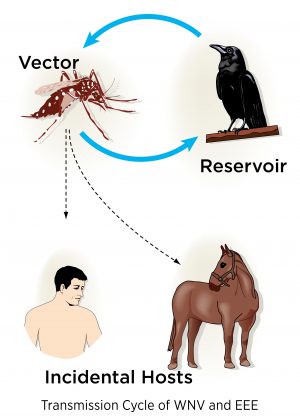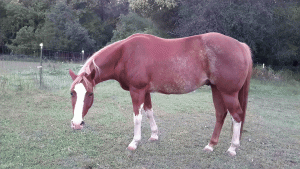
In Michigan and the Northeast, state health departments are warning residents about a disease transmitted by mosquitoes that they may never have heard of: Eastern Equine Encephalitis (EEE). The most recent information (Tuesday, September 17, 2019) from the Michigan Department of Health and Human Services (MDHHS) reports seven confirmed human cases of EEE; three of which have been fatal.
As the name suggests, EEE also is a disease of concern for horses and other equines. Early this summer, the Michigan Department of Agriculture and Rural Development (MDARD) issued information for horse owners and veterinarians about increased risk for EEE for Michigan horses in 2019. As of Thursday, September 19, 2019, Michigan has had confirmed cases of EEE in nine horses, five free-ranging white-tailed deer, and one donkey. MDARD reports equine cases to the Equine Disease Communication Center and updates on EEE activity in Michigan can be found on the MSU Veterinary Diagnostic Laboratory website. A weekly summary of all arbovirus activity in Michigan is available through MDHHS.
In horses, EEE is particularly concerning because horses with the disease have a low chance of survival. The disease causes neurological issues and the most commonly reported signs of EEE are incoordination, inability to stand, lethargy, seizures, and tremors.
Arbovirus Transmission

EEE and West Nile Virus (WNV) are viruses that are spread by mosquitoes or other biting insects, known as arboviruses. Birds are amplifying hosts for both viruses. EEE virus may be detected in multiple species of birds in the Eastern United States.
Outbreaks and deaths from EEE have been seen in pheasants, domestic turkeys, ostriches, emus, rock doves, house sparrows, and penguins. In addition to birds, rodents and snakes also may serve as reservoirs for EEE. EEE is transmitted by various types of mosquitoes, in particular Cutiseta melanura, which prefers to feed on birds.
For both WNV and EEE, the virus is amplified in infected birds. Female mosquitoes pick up the virus by feeding on infected birds. The virus lives in the mosquitoes and is transferred to a variety of incidental hosts including humans, horses, and other mammals, such as cats, dogs, livestock, and wildlife.
Seasonality
Because both diseases are spread by mosquitoes, they are seasonal and most often diagnosed in late summer through early fall. Rainfall and temperature patterns play a critical role in how successful these viruses are in the infection of birds and mosquitoes, and ultimately, animals and humans. Therefore, the number of cases and affected species can vary widely year to year.
For example, in 2017, Michigan had 7 cases of EEE and 15 cases of WNV in horses including the first-ever reported mosquito-transmitted equine diseases in the Upper Peninsula. In contrast, in 2018, arboviruses in Michigan were primarily a human health concern which is often the case during dry summers. As of Monday, October 1, 2018, Michigan had no cases of EEE, and only two cases of WNV, in horses. In contrast, 77 human cases of WNV or other arboviruses had been reported, including one case of EEE.

Prevention and Protection
Vaccination is the most important prevention strategy for EEE and WNV infection in horses. There are no vaccines approved for use in humans. Horse owners and the public can protect themselves and animals by applying mosquito repellent, eliminating standing water, and bringing animals indoors from early evening until after sunrise when mosquitoes are most active.
Information on the prevention of arbovirus infections in humans, signs and symptoms, treatment, and the current number of detections in Michigan is available on Michigan’s Emerging Diseases website, which is managed by MDHHS. Additional information is also available through the Centers for Disease Control and Prevention.
Diagnostic Testing for Animals
The Michigan State University Veterinary Diagnostic Laboratory offers tests for both WNV and EEE. Samples from sick or dead domestic or exotic animals can be submitted by veterinarians. More details on testing options and other information for the veterinary community are available in the Summer 2018 issue of the Laboratory’s newsletter, Diagnostic News, and in the Laboratory’s test catalog.
The Laboratory also performs testing for WNV and EEE for Michigan wildlife, including birds, for the Michigan Department of Natural Resources. Residents are encouraged to report sick or dead wildlife to the Michigan Department of Natural Resources.
